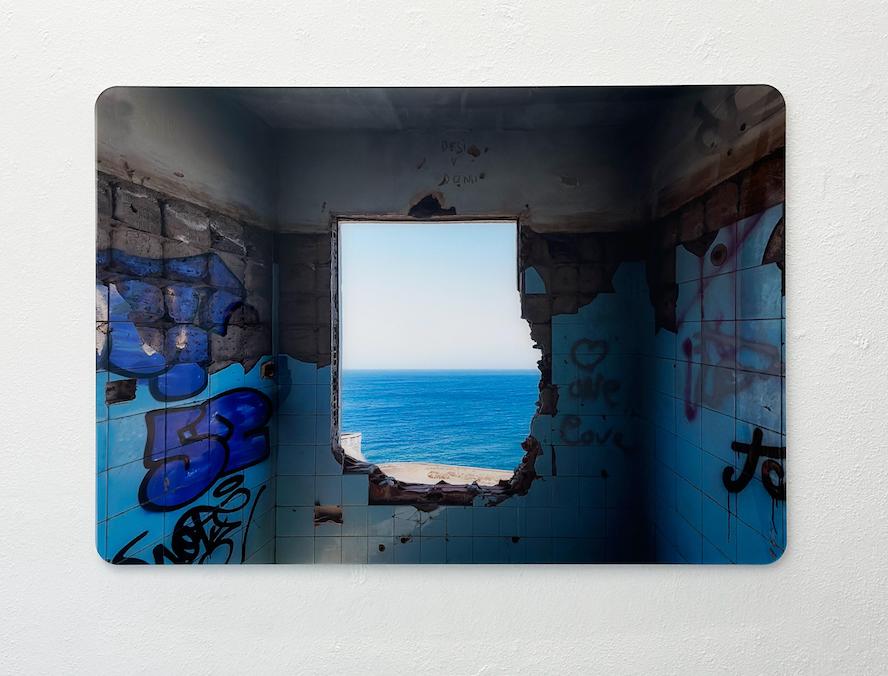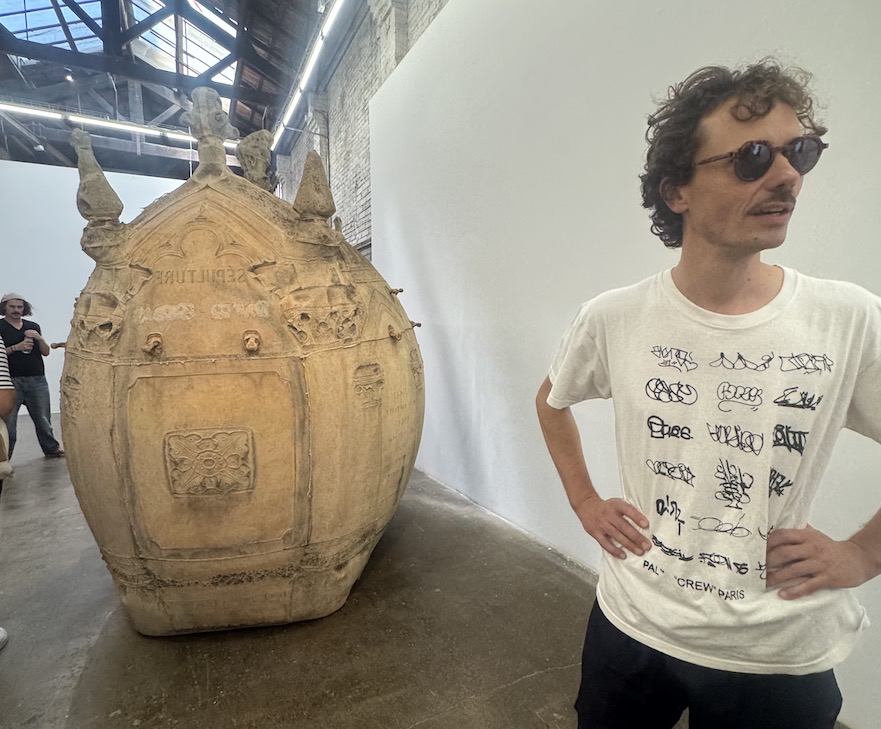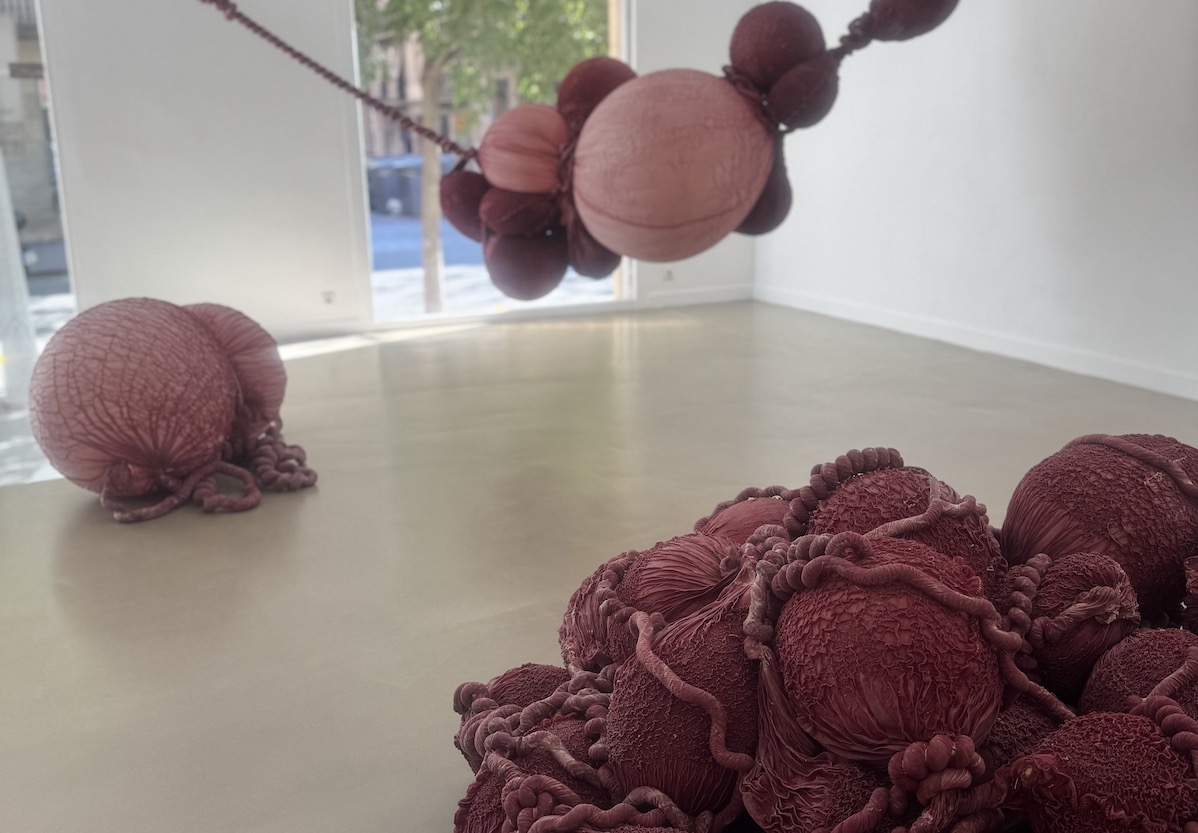Barcelona has always been one of my favourite European cities, with the Sagrada Família and Gaudí’s remarkable architecture set against the Mediterranean backdrop. Although I had never attended Gallery Weekend before, I was delighted to join its 11th edition, held from September 18 to 21 and organised by Andrea Rodríguez Novoa of Art Barcelona.
With 24 participating galleries spread across the city, the program offered a dynamic mix of exhibitions, performances, and studio visits that attracted curators, collectors, and art enthusiasts alike. Beyond the official agenda, the event fostered a vibrant spirit of exchange—galleries and courtyards became gathering spaces where conversations unfolded and lingered well into the night.
I began my Gallery Weekend at Suburbia Contemporary Gallery, where Florence-born artist Giovanni Ozzola presented Life and Death Are Wearing Me Down. His large-scale photographs revealed a graffiti-covered bunker cut open to glimpses of sky and sea—a stark collision of confinement and openness. The work urged viewers to confront inner limits and imagine broader horizons. Known for his sensitivity to light, Ozzola explored themes of infinity and discovery, both outward and inward.

That same evening, Ozzola staged his performance, The Lake of the Unknown, using slate stones to inscribe luminous traces, evoking ancient maps and languages as a meditation on time, loss, and humanity’s search for meaning. The piece echoed his work Scars – towards ourselves, where 60 engraved slate slabs chart historic sea routes, transforming them into metaphors of life paths and collective memory. Together, these works linked exploration with the human drive to record, orient, and overcome fear—uniting past and present through shared inscriptions on stone.
At Fundació Vila Casas, I especially enjoyed Toni Giró’s retrospective. Bringing together sculpture, video, installation, photography, and drawing, the exhibition revealed the full scope of his practice. Giró’s focus on language and translation, and the playful yet critical ways he used images and words, offered a sharp reflection on how we perceive and interpret the present.

Two emerging voices also stood out with sculptures that used latex to give shape to air itself. At Galería Alegría, French artist Ken Sortais presented Lo inverso es recíproco / The Inverse Is Reciprocal. His “Sculpt’air” latex inflatables looked swollen and unstable, as if on the verge of bursting. Created by casting pigmented latex around moulds and inflating them, the works transformed familiar forms into distorted, balloon-like effigies. Many derived from impressions he clandestinely took of religious or mythological statues—sometimes in cemeteries, often at night. The results combined irreverence with fragility, producing objects that felt both sacred and precarious.
Bombon Projects showcased a new series by Barcelona-born Eva Fàbregas (see lead image), whose practice often unfolds through soft, tactile materials. I was completely absorbed by her biomorphic sculptures, which invite engagement through touch and bodily perception. Both playful and uncanny, the pieces blur the line between organic and inorganic, human and non-human.
Visiting her studio—shelves overflowing with colourful materials and experiments— revealed how deeply her practice grows from intuition, trial, and material exploration, where mistakes and chance discoveries become essential. What began as an accident with resin moulds eventually evolved into latex-based forms, their elasticity opening a visceral, embodied process. Rather than relying on strict methods, Eva leans into unlearning and play, letting curiosity, touch, and bodily presence guide her making. Her sculptures resist easy categorisation, emerging instead through mutation and metamorphosis. They hint at organic or speculative forms without directly imitating nature, privileging sensation and affect over analysis. In this way, space and architecture become collaborators, as her soft, adaptive materials respond to and are shaped by their surroundings—works that behave like empathic presences in dialogue with their sites.
On another scale, at ProjecteSD, the Valencian artist LUCE presented Buscando donde no hay nada / Searching Where There Is Nothing. His exhibition featured small-format works on paper and found objects arranged into a map-like mural. Each piece recorded his movements through Valencia, a city in visible transformation. The works read like fragments of an urban diary, showing how absence and overlooked spaces can become markers of presence and memory.
Prats Nogueras Blanchard Gallery revisited the visionary projects of Christo (1935– 2020) and Jeanne-Claude (1935–2009). Visitors encountered a selection of the couple’s unrealised works. Known for their monumental wrappings, they treated unexecuted projects as complete artworks, producing drawings, models, and proposals with meticulous detail. Most remained unrealised due to a lack of permission, and they consistently rejected commissions and sponsorships to protect their independence. One such project was their plan to wrap Barcelona’s Christopher Columbus monument. After years of refusals, permission was finally granted in 1984—but by then, the artists had moved on, leaving the idea as an unfulfilled vision. The exhibition underscored imagination and autonomy as central to their practice, where even absence became part of their legacy.
Saturday evening began with a private visit to MACBA, where director and curator Elvira Dyangani Ose welcomed us into the exhibition of the Cuban-American artist Coco Fusco. Hearing about the work through her lens brought alive the depth of Fusco’s long engagement with colonialism, power, race, gender, and history. The title I Learned to Swim on Dry Land—borrowed from Virgilio Piñera’s microfiction Swimming—felt especially poignant, connecting the project to questions of U.S. immigration, the rise of the right wing, and the pressures of cultural monoculture. Moving through the rich documentation, objects, and traces of Fusco’s performances, I saw how her research transforms into art. The evening closed beautifully in MACBA’s Chapel of the Convent, with a performance by Élan d’Orphium.
Over the course of four days of Barcelona Gallery Weekend, I cherished the conversations with collectors, artists, and fellow professionals. The atmosphere was intimate and welcoming, encouraging exchanges, discoveries, and even new friendships. While I couldn’t determine the exact number of Gallery Weekends worldwide—likely between 30 and 50, certainly fewer than art fairs—their appeal is clearly growing. At a time when many galleries face economic challenges and collectors are experiencing fair fatigue, the Gallery Weekend format offers a refreshing alternative: lower overhead, deeper curatorial focus, and a more human scale.
That said, Gallery Weekends don’t replace the unique visibility and international reach of art fairs, which remain vital moments for the art world. With Frieze and Art Basel Paris just around the corner, the balance between the two formats feels more relevant than ever.
Barcelona Gallery Weekend 18-21 September 2025

